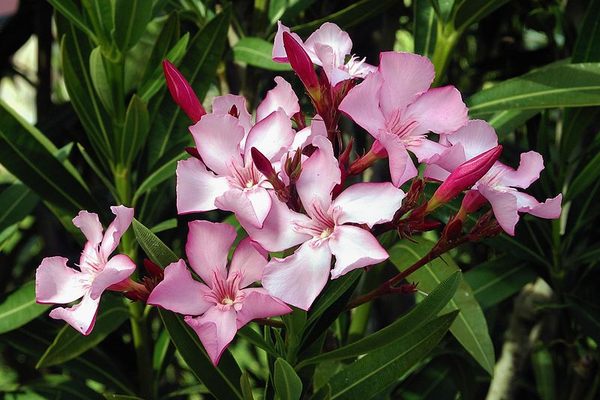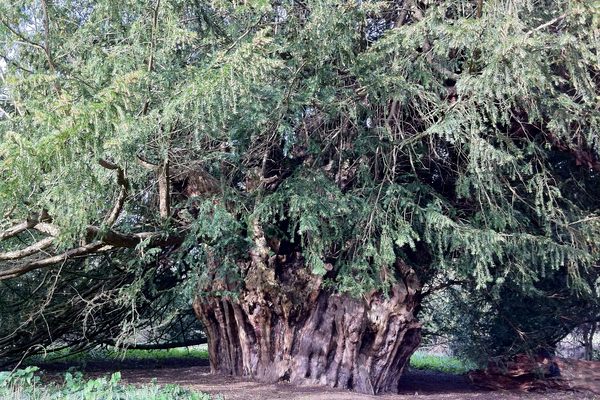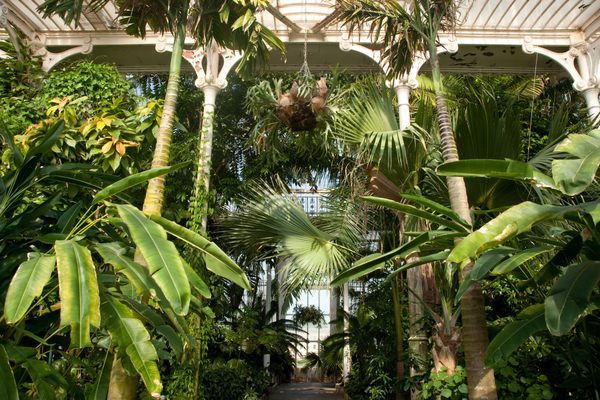Where the Deadly Things Grow
Sign at Alnwick Poison Gardens (photograph by Jo Jakeman)
Compared to fauna, flora and fungi have a pretty mellow reputation where humans are concerned. Unsubstantiated rumors of man-eating pitcher plants aside, most growing things mind their own business, clean the atmosphere, lynchpin ecosystems, and provide sustenance for the animals, homo sapiens included. Some, however, contain deadly poison.
Human beings have discovered which plants are poisonous through unfortunate accidents, only to turn around and make use of this knowledge. Just ask Socrates. Whether growing wild or carefully cultivated, deadly plants can be found all over the world, often inspiring mythology, folklore, and devotion that says far more about human beings than it does about botany.
English Yew (Taxus baccata)
England

Churchyard Yew illustrated in Charles Tilt’s “Woodland Gleanings” (1853) (via Project Gutenberg)
The long-living English Yew tree is a shrub-like evergreen found across Great Britain, including in many church yards and graveyards. Historians believe this is not an accident, as the trees were likely a part of pagan holy sites that existed before the churches were built. Both pagans and later Christians came to associate the tree with the soul and with death, most likely because of its highly toxic properties, and possibly because of its eerie appearance.
Scotland’s Fortingall Yew (photograph by Paul Hermans)
Myths about the yew are plentiful. One story espouses their usefulness in undead prevention because their fine roots grow through the eyes of the dead, preventing them from seeing their way to the surface. Another, slightly more romantic tale, says that two yews entwined were the reincarnation of lovers executed via yew stakes to the heart. Famous examples of the yew tree include the Ankerwycke Yew, which grows on the grounds of a former convent, and Scotland’s Fortingall Yew, which grows in a village churchyard and which some claim is 5,000 years old.
Nearly every part of the tree can be fatal to a human, owing to the rich amounts of the toxin taxus baccata. On top of that, there is a long history of people making weapons, including deadly longbows, from the trees. On the upside, in recent years, the tree has been processed into medicine, including chemotherapy drugs.
Poison Hemlock (Conium maculatum)
Europe
Socrates holding a cup of Hemlock (via Library of Congress)
In her book, Wicked Plants, Amy Stewart tells the story of an unfortunate Scottish tailor who in 1845, eats a sandwich prepared by his children, who had collected the wild greens themselves. He died a few hours later.
Hemlock growing in Lincolnshire, UK (photograph by Mick Talbot)
The children had likely mistaken poison hemlock for parsley, which it resembles. It’s roots also happen to resemble carrots and that, too, has lead to deadly mistakes. It grows as a weed on the roadside, in drainage ditches, and on the edge of cultivated fields across Europe, and in England has often been associated with witchcraft. As it did in Socrates’s time, it has been used to facilitate human death for millennia. On top of that, there are persistent stories of it growing beneath the cross during the crucifixion, mythology which is reinforced by the red speckles which appear on the plant during the spring (usually right around Easter).
Death Cap Mushroom (Amanita phalloides)
Europe, Asia, and the United States
According to a 2014 Slate story, those who lived to tell of eating the aptly named Death Cap Mushroom say it was the most delicious mushroom they’d ever eaten. The Death Cap — which is a fungi, not a plant — contains a number of toxins, but looks nearly identical to the edible Paddy Straw Mushroom. Both species grow wild in forests across Europe, Asia, and the United States. Because they form a symbiotic relationship with tree roots, Death Caps are most often found near hardwood trees like oak and pine.
Warning sign for Death Cap Mushrooms, Canberra, Australia (via AYArktos/Wikimedia)
Thanks to Paddy Straws being popular in many Asian cuisines and the easy misidentification, the aptly named Death Cap is thus responsible for the vast majority of mushroom poisoning deaths. Case in point, a couple living on the Isle of Wight picked some of these mushrooms from a botanical gardens, assuming they were the consumable variety. The couple’s aunt later passed away from eating the toxic fungi.
Thankfully, scientists have developed a treatment for death cap poisoning that shows great promise, but it is not yet widely available.
The Suicide Tree (Cerbera odollam)
India
The state of Kerala, on the southern tip of India, is know for many things. Bull Surfing, fisheries, rice paddies, tea farms, and a suicide rate well above the national average.
The Suicide Tree (photograph by Agnes Rinehart)
One of the reasons cited for that last bit of grim notoriety is the plentiful abundance of Cerbera odollam, know colloquially as the Suicide Tree, which grows in salt marshes and other swampy areas. Tea or food made from the Suicide Tree has been the go-to method for those wanting to take their own life for generations, and more recently the tree has been suspected as a “perfect” murder weapon in a slew of suspicious deaths.
Since the toxic glycosides in the tree leave nary a trace and mix well with food, it’s convenient for suicides who want to avoid shame and murderers who don’t want to tip off authorities. While some people are content to blame the tree, recent social programs have sought to lower the deaths by Suicide Tree in Kerala by addressing the underlying sociological causes, and not by blaming commonplace vegetation.
Snake Root (Ageratina altissima)
North America
Snake Root is a tiny flower native to North America. It contains the toxin tremetol and was responsible for thousands of deaths during the 1700s and 1800s.
Snake Root (1913 illustration) (via USDA PLANTS Database)
photograph by Bob Heitzman
European settlers, unlike the native population, were unfamiliar with the pleasant-looking flowering weed and did not recognize the danger it posed to their livestock and themselves. When eaten by a cow, the plant renders her milk and meat poisonous. Those unfortunate enough to consume a poisonous cow product, most notably Nancy Hanks Lincoln, would become violently ill with vomiting and trembling. The future president was only nine years old when his mother succumbed to the poison, one of several people in the town of Pigeon Creek, Indiana to contract what was known as “milk sickness.”
It took many decades for scientists to connect milk sickness to snake root, but now the plant is kept far away from grazing livestock. Today, it grows in forests in the south and central United States, especially along streams, and is sometimes mistaken for ordinary nettles.
Water Hemlock
North America
Water Hemlock (via Wikimedia)
Like its European cousin Poison Hemlock, Water Hemlock bears an unfortunate resemblance to edibles like cilantro and carrots, and grows in wetlands all over North America, especially in Western States where it continues to be a threat to livestock.
Scores of people have died over the years, including when in 1992 a young man in Maine mistook it for wild ginseng. It’s even thought that a person can suffer mild symptoms just by handling the plant and there are claims that people have been poisoned by using the hollow stems as straws.
Oleander (Nerium oleander)
Gardens Across the United States and Europe
Oleander (via Library of Congress)
It seems at the very least unwise, but two of the deadliest plants to humans are ubiquitous in ornamental gardens all across the world, especially in the United States and Europe.
So widespread is the cultivating of oleander in warm climates that botanists are unsure of its regional origins. Popular for its vibrant colors, oleander is a hearty, decorative shrub commonly planted in public spaces and private backyards and gardens, despite containing the deadly toxins known as glycosides. It is even the official flower of Galveston, Texas, which holds an Oleander Festival annually, and has an oleander park where the plant grows.
Oleander illustrated by Lena Lowis (1878) (via Wikimedia)
The fear of oleander is so endemic in American culture that one of the most persistent urban myths listed on snopes.com tells the story of a troop of unlucky boy scouts (sometimes girl scouts) that uses oleander sticks to toast marshmallows and dies as a result. The incident never happened, and it is highly unlikely marshmallows toasted on oleander sticks would be fatal. However, people should still fear the plant.
Ingesting just a few of its leaves would kill a human, as visitors to the Myrtles Plantation in Louisiana find out, since oleander poisoning features in the estate’s ghostly history. Legend has it that a servant looking to ingratiate herself with the family baked some oleander leaves into a cake, thinking this would be a holistic cure for some ill children. The children and their mother died, the servant was hanged, and ghostly apparitions ensued.
Castor Bean Plant (Ricinus communis)
North America and Europe
1887 illustration of castor bean by Franz Eugen Köhler (via Wikimedia)
The other deadly garden resident is the castor bean. Although castor oil, derived from the castor beans, is used both for medicinal purposes and as an industrial lubricant, the plant contains ricin, a toxin so deadly to human’s that castor bean plants are consistently ranked at the top of the world’s most deadly plants. Fans of the American television show Breaking Bad will recognize it as the plant from Walt’s garden from which he made ricin to poison his enemies (or in one case, the child of his enemy’s girlfriend).
Making castor bean plants even more spooky is that fact they come in enough various forms, owing to breeding for different purposes, that it can be tricky to recognize them. They are native to the Mediterranean and grow as an ornamental tree in countries like Greece, while in more temperate climates in the United States are grown as an annual.
Africa
Ratbane (Dichapetalum cymosum and D. Toxicarium)
Ratbane (via eol.org)
For thousands of years, Ratbane caused very little trouble in its native West Africa. Local fauna coexisted with the plants for thousands of years, likely developing an immunity. Local people knew not to eat it. But with the arrival of Europeans and their livestock, the plant quickly became a threat to grazing animals, killing them in large numbers.
It also caught the attention of the pest control industry as a potential poison for rats and other mammals, including coyotes. The plant contains powerful poison sodium fluooacetate, which was extracted and widely used to kill unwanted mammals, including being placed into livestock collars designed to kill attacking coyotes that bit the animal on the neck. Ratbane was banned for commercial use in the United States in 1972, but the plants still grows wild and plentiful across Africa and livestock farmers have learned to manage it so as not to expose their herds.
The West Indies
Jequirity Beans (Abrus precatorius)
(via USGS Plants of Hawaii)
Handcrafted jewelry and musical instruments from the West Indies are often made with ladybug-like beans from a plant known as the Rosary Pea or as Jequirity Bean. These “all natural” beads contain the deadly poison abrin, which is similar to ricin. So potent is the poison that it is thought that if a jeweler punctures the beads while stringing them, exposure to the poison could be fatal. More well-documented are the cases of jewelry owners ingesting a bead and dying. Although the outer shell is so hard that if it’s not chewed or punctured, the beans can pass through the body harmlessly. The operative word being if.
Despite the risk, products made with the beads are widely available and make their way into stores. In 2011, a number of British retailers recalled thousands of bracelets that were for sale in gift stores across the UK after a botanist who worked at a horticulture attraction alerted authorities. The plant is probably native to Indonesia, but grows copiously and invasively in tropical climates and jungles around the world including in as far flung places as Trinidad & Tobago, India, Hawaii, and the southern United States.
Toxic Blue-Green Algae (Cyanobacteria)
Everywhere
Scientists don’t know what causes a normally harmless population of blue-green algae to suddenly go all serial killer and release toxins on a large scale, but they do, and occurrences are getting more frequent. These unpleasant events, known as a bloom or red tide, can happen pretty much anywhere algae lives in the world (saltwater or fresh), and if it happens in a place where humans or animals or fish are exposed, deaths and sickness often follow. Although human fatalities do occur, the major danger is to fish and other aquatic life, and the resulting economic damage can be significant.
2010 Filamentous Cyanobacteria Bloom near Fiji (via NASA Earth Observatory)
Blue-green algae is also the oldest species on this list, with fossilized remands indicating that they’ve been around and doing their thing before the other life forms on this list existed. Scientists have determined that they were essential in the evolution of plant life and the developing of Earth’s life-encouraging atmosphere.
In fact, every deadly thing on this list plays an important part in the ecosystem that sustains all life on Earth. Some even provide life-saving medicine or extremely helpful industrial products. Most of them are beautiful, and all of them should, like nature itself, be respected.
















Follow us on Twitter to get the latest on the world's hidden wonders.
Like us on Facebook to get the latest on the world's hidden wonders.
Follow us on Twitter Like us on Facebook